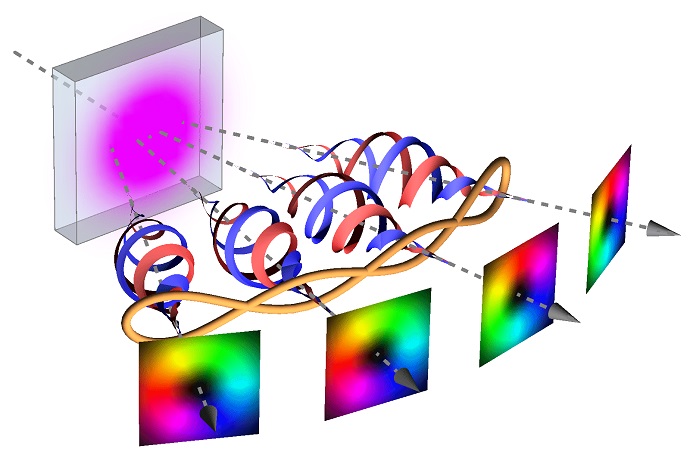01 February 2016
An important discovery makes it possible to communicate complex information among multiple people without the message being cracked. The communication can also relate to complex information.
For the first time, scientists have entangled four photons in their orbital angular momentum. Leiden physicists sent a laser through a crystal, thereby creating four photons with coupled ‘rotation’. So far this has only been done for two photons. The discovery makes uncrackable secret communication of complex information possible between multiple parties. Publication in Physical Review Letters on February 1st. Pre-print on Arxiv
Our current computers communicate with light signals (photons) via glass fibres. A light signal is a kind of morse code: on-off, on-off, corresponding with the value 0 or 1 of one bit. Entanglement is one of the great promises of quantum mechanics, with such applications as uncrackable secure communication and quantum computing. If two photons are created simultaneously, they are one another’s mirror image, so they will also have opposite twist: the other one will be right-twisted or vice versa. However, the twist is undetermined before the measurement. This is a key feature of quantum entanglement.
Entanglement holds a great promise, with applications in perfectly secret communication and quantum computing. If two photons are created simultaneously, they are each other’s counterpart, so that their ‘rotation’ is always reversed with respect to the other. If we measure left ‘rotation’ for one photon, then the other will always ‘rotate’ to the right after measurement with a similar filter. This is called entanglement. Before the measurement, each photon’s ‘rotation’ is undetermined.
Milestone
This ‘rotation’ is a property of photons that scientists discovered in 1992 in Leiden; physicists call this orbital angular momentum. And this property has more than two values. It covers an infinitely large alphabet of information. So with this you can transfer much more information per photon than with a property like polarization, which contains only two possible values. In 2001, scientists managed to entangle two photons in orbital angular momentum for the first time. Now, Leiden physicist Wolfgang Löffler and his colleagues are the first ones to entangle four photons in this way. They announce it in an Editor’s suggestion article in Physical Review Letters. The discovery offers many extra possibilities, like sending an uncrackable encrypted message to more than one party.
Experiment
During their successful experiment, the researchers sent short ultraviolet laser pulses of two picoseconds through a crystal. Occasionally this leads to the creation of four entangled photons. This is extremely rare, but by generating 80 million pulses per second they managed to detect on average two so-called photon quadruplets each second. To confirm these were indeed entangled in orbital angular momentum, the team used a spatial phase modulator that converts this ‘rotation’ back to light travelling as a plane wave. They registered this ‘normal’ light with single photon detectors.
Article
Observation of four-photon orbital angular momentum entanglement, B. C. Hiesmayr, M, J. A. de Dood, W. Löffler, Physical Review Letters. Pre-print on Arxiv.















